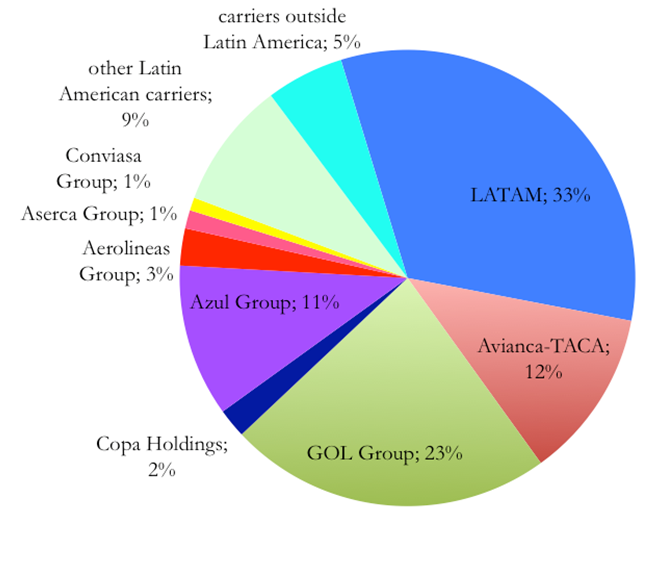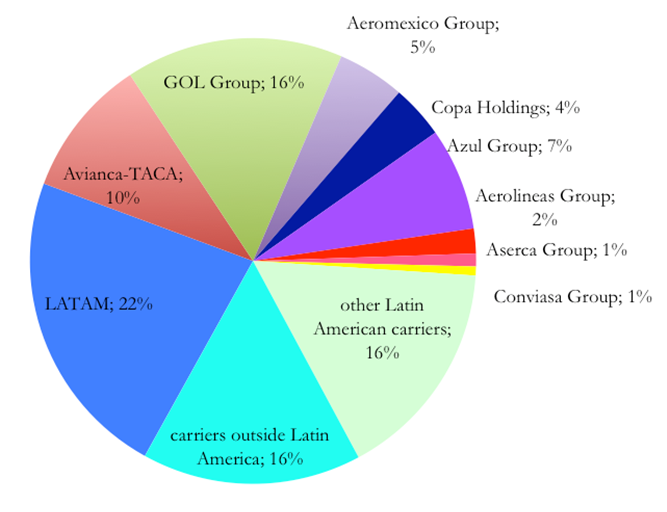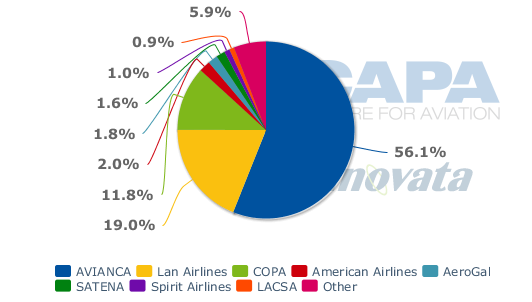New LAN-TAM parent Latam emerges as a leader globally and a powerful force across South America
Latin American airline groups LAN and TAM have finally completed their historic merger, creating a single powerful group which accounts for about one-third of total capacity in the fast-growing South American market. Latam Airlines Group is the market leader in Brazil, which is by far the largest market in Latin America and one of the four BRIC countries, and in three smaller South American countries - Chile, Peru and Paraguay. Latam is also the second largest player in another three South American markets - Argentina, Colombia and Ecuador.
Latam was formally established on 22-Jun-2012, when the LAN and TAM merger transaction was finally completed, ending a drawn out 22 month process that began in Aug-2010 with the signing of an memorandum of understanding between Latin America's two largest airline groups (by revenue). Trading of Latam shares began on 27-Jun-2012 in New York, Sao Paulo and Santiago as TAM shares were delisted.
All shares of LAN have turned into shares of Latam as the original LAN listing was the vehicle for the transaction while TAM shares have been converted into LAN shares at a ratio of 1 to 0.9. Roughly 50% of Latam is publicly held, with LAN's Cueto family and TAM's Amaro family holding most of the remaining stake.
Longstanding LAN CEO Enrique Cueto has taken over as CEO of Latam while Mauricio Rolim Amaro is serving as the new group's chairman. Mr Cueto will now lead an integration process that is expected to take up to four years and generate USD600 million to USD700 million in annual synergies. But LAN and TAM will retain their separate operations and brands while as a group Latam is expected to retain separate air operators' certificates in all seven of the South American countries where it bases aircraft.
Latam must meet several merger conditions including single alliance requirement
The LAN-TAM merger was originally expected to take only eight to 12 months to complete but encountered repeated delays. The biggest delay was caused by a lengthy investigation by anti-trust authorities in LAN's home market of Chile. The Chilean anti-trust court TDLC finally approved the proposed merger in Oct-2012 subject to several conditions and mitigation measures being implemented. Chile's Supreme Court subsequently upheld the ruling in Apr-2012, rejecting an appeal from LAN on three of the conditions.
The conditions include a requirement that prohibits the group's airline subsidiaries and affiliates from being aligned with more than one global alliance. Special approval must also be secured for any codeshare with carriers outside the one alliance Latam chooses, which is expected to be oneworld due to a separate requirement which prohibits Latam from being in the same alliance as rival Latin American airline group Avianca-TACA. TAM is currently a member of Star while Chile's Lan Airlines and three of its affiliates (Lan Argentina, Lan Ecuador and Lan Peru) are members of oneworld. Avianca, TACA and TACA Peru joined Star last week, making it legally impossible for LAN or TAM to also be in Star.
See related article: Avianca-TACA and Copa put Star on top in Latin America but the victory will be short-lived
Latam also is required to give up some of its traffic rights at its hub at Lima, where affiliate Lan Peru is the market leader with a much larger share of both domestic and international traffic than Avianca-TACA affiliate TACA Peru. To appease anti-trust authorities, LAN and TAM also offered last year a series of mitigation measures covering the Santiago-Sao Paulo route, where Latam now has a monopoly position and controls all of the roughly 20,000 weekly round-trip seats. Any new airline willing to launch service on Santiago-Sao Paulo will be provided with slots at Sao Paulo Guarulhos from Latam as well as the opportunity to codeshare or interline on the route with LAN and TAM.
See related article: LAN-TAM offer concessions to increase competition on Santiago-Sao Paulo route
Latam brings together two highly complementary networks
Santiago-Sao Paulo is one of only a handful of routes that both LAN and TAM currently operate. Other routes where both carriers operate - such as Lima-Sao Paulo, Buenos Aires-Sao Paulo and Bogota-Sao Paulo - already have competition.
With the exception of the very small number of overlapping routes the LAN and TAM networks are highly complementary. TAM is the largest carrier in Brazil and Paraguay, where it has a small subsidiary. It is primarily focused on the domestic market, which currently accounts for about 90% of its total seats and over 60% of its ASKs. In comparison, LAN is more international focused with only about 35% of its ASKs allocated to domestic markets.
LAN consists of passenger airlines in five South American countries and accounts for the majority of capacity in two of these markets - Chile and Peru - while it is the second largest player in Argentina, Colombia and Ecuador. While LAN operates domestic services in all five of these countries, its real strength is on regional international routes within Latin America, a fast-growing and increasingly important market. In 1Q2012, 25% of LAN's ASKs were in the regional international market. LAN has been expanding capacity in the intra-Latin America international market at a clip exceeding 15%. LAN also operates long-haul services to North America, Europe and Australasia, which account for about 40% of its ASKs.
While Latam only operates about 50,000 seats per week outside the Americas (and about 110,000 weekly seats outside of Latin America and the Caribbean), the ramifications of the merger are global. Latam is now among the top 15 largest airline groups in the world by revenue and traffic. In terms of market capitalisation, Latam has overtaken Air China as the world's most valuable airline group.
The merger also has global implications for the alliances as Star, oneworld and SkyTeam await Latam's formal selection. With Avianca-TACA now part of Star and SkyTeam essentially ruled out given its new affiliation with Aerolineas Aregentinas and invitation to TAM rival Gol, the options are moving TAM to oneworld or have TAM become non-aligned. The implications of this decision are huge as oneworld is poised to take over as the largest alliance in Latin America should TAM move to oneworld as expected.
Mergers leave 80% of South American capacity in the hands of four big groups
Avianca-TACA itself is a by-product of a major merger which was consummated in Oct-2009 and quickly completed in Jan-2010. While Avianca-TACA is smaller than LAN or TAM was individually, the merger between Colombia's Avianca and Central American consortium Grupo TACA sparked a wave of consolidation in Latin America. In signing the MOU to merge with TAM and create Latam just eight months after Avianca-TACA Holding was formally established, LAN's Mr Cueto stated that "as the industry consolidates we cannot sit still".
Not surprisingly the LAN-TAM marriage of giants has been followed by additional consolidation movements in South America. Gol last year unveiled plans to acquire Webjet and earlier this year two other Brazilian carriers, Azul and TRIP agreed to merge.
Once all the mergers are completed, nearly 80% of capacity in South America will be controlled by only four airline groups. This includes a 33% share of capacity at Latam, a 23% share by Gol, a 12% share by Avianca-TACA and an 11% share by Azul. The Avianca-TACA share includes the 3% share of South American capacity held by Avianca Brazil, which has not yet but is expected to eventually join South American sister carriers Avianca, AeroGal (Ecuador) and TACA Peru in Avianca-TACA Holding.
South America capacity share by airline group (% of seats): 25-Jun-2012 to 01-Jul-2012
The top five groups in South America control 82% of the market after factoring in Aerolineas Argentinas and its domestic unit Austral, which account for about 3% of total capacity. When also factoring in Copa Holdings, which consists of Panama-based Copa Airlines and Colombian subsidiary Copa Colombia, the six largest airline groups in South America account for 84% of total capacity.
This portion of the South American market controlled by the largest six groups increases to over 88% when excluding the capacity provided by carriers from outside Latin America. About 5% of all capacity in South America now comes from non-Latin American carriers, primarily US carriers (American, Delta and United combined account for just over 2% of total South American capacity).
In the broader Latin America market - that includes Central America, Mexico and the Caribbean as well as South America - Latam now accounts for just over 22% of total capacity. The leading six groups in the Latin America and Caribbean region now account for about 64% of total capacity. This includes a 16% share by Gol, a 10% share by Avianca-TACA, a 7% share by Azul, a 5% share by the Aeromexico Group (which includes Aermexico and regional subsidiary Aeromexico Connect) and a 4% share by Copa Holdlings.
Latin America capacity share by airline group (% of seats): 25-Jun-2012 to 01-Jul-2012
In the broader Latin America market, the share of capacity provided by the six largest groups is significantly smaller than South America primarily because of the Mexican market, where three independent LCCs account for over one third of total capacity. The Mexican market, which is the second largest in Latin America after Brazil, also has a higher share of capacity from non-Latin American carriers due to the large presence of US carriers. About 16% of total capacity in Latin America and the Caribbean is now provided by carriers outside the region. When excluding this capacity, the six largest airline groups in the region account for about 76% of capacity in Latin America including about a 27% share at Latam.
Latam could potentially further grow its share of the Latin American market by acquiring or launching a passenger airline in Central America or Mexico. Latam already has a Mexican cargo airline affiliate in MAS Air (it also has cargo airline subsidiaries or affiliates in Brazil, Colombia and the US).
Avianca-TACA and Copa Holdings already have subsidiaries in both Central and South America, potentially putting pressure on Latam to look at making a move further north. While Copa is relatively small, the group is the leader in the intra-Latin American market, which according to RPK data from Latin American airline association ALTA grew by 10% in 2011 and by 22% through the first four months of 2012. Copa, Avianca-TACA and Latam are now battling in this important market, with Copa's Panama City base the leading hub for intra-Latin America international traffic followed by Lima, where both Avianca-TACA and Latam have affiliates.
Latam and Avianca-TACA are top two airline groups in three South American markets
Avianca-TACA Holding has subsidiaries or affiliates in five Central American countries - Costa Rica, El Salvador, Guatemala, Honduras and Nicaragua - in addition to its South American subsidiaries or affiliates in Colombia, Ecuador and Peru. Avianca-TACA Holding and Latam are now fierce competitors in Colombia, Ecuador and Peru, and will be in Brazil once ownership of Avianca Brazil shifts to Avianca-TACA Holding.
In Colombia Avianca is the largest single carrier, accounting for about 69% of total capacity (seats) while LAN is the second largest carrier with about a 19% share of total capacity, according to Innovata data. Copa is also a major competitor in Colombia, accounting for about a 12% share of total capacity in the Colombian market.
Colombia system-wide capacity share by carrier (% of seats): 25-Jun-2012 to 01-Jul-2012
In Peru, Latam carriers including Lan Peru accounted for 56% of all passengers in 2011, according to Peruvian DGAC data. Avianca-TACA carriers including TACA Peru only accounted for 12% of passenger traffic in Peru last year. TACA Peru is the second largest international carrier in Peru after Lan Peru while domestically TACA Peru was the fourth largest carrier in 2011 after Lan Peru, Star Peru and Peruvian Airlines.
In smaller Ecuador, government-owned TAME is still the largest carrier with a 34% share of total capacity, according to current Innovata capacity data. But LAN (including Lan Ecuador) is the second largest player in the Ecuadorean market with about a 26% share of seats while Avianca-TACA (including AeroGal) accounts for about 23% of total capacity, according to Innovata data.
In its home market Chile, LAN currently accounts for a controlling 63% share of capacity and Latam as a group accounts for about 66% of total capacity. In much larger Brazil, TAM accounts for about 33% of total capacity (seats) and as a group Latam has about a 34% share. The new Gol-Webjet combination is slightly larger in terms of seat capacity, accounting for a 35% share. But Latam is the Brazilian market leader by a wide margin based on ASKs, RPKs or revenues. TAM is also the market leader in neighbouring Paraguay, where its TAM Paraguay subsidiary currently accounts for just over 50% of seat capacity.
Combined LAN and TAM generated over USD13 billion in revenues in 2011 and carried over 60 million passengers. The combined LAN-TAM traffic figure accounts for 43% of the total passenger traffic reported for 2011 by Latin American airline association ALTA.
Further consolidation in Latin America, and globally, is likely
With such a powerful force having been unleashed in a single market, further consolidation is almost inevitable. It is unlikely Latam can get away with yet another acquisition in South America. LAN's acquisition of Colombia's Aires (now known as Lan Colombia), which was done just a few months after agreeing to the merger with TAM, will probably be its last in South America. But Avianca-TACA could potentially look to make another acquisition to close the big gap with LAN, with Chile's second largest carrier Sky a particularly attractive target. Sky already codeshares with both Avianca and TACA.
See related article: Avianca-Sky tie-up and LAN-TAM alliance selection could lead to further consolidation in LatAm
Sky is now the largest airline in South America that is not part of one the region's six leading groups. Sky is the 11th largest carrier in South America and accounts for about 1.5% of total capacity in South America, according to current OAG capacity data.
Other South American airlines outside the big six include Uruguay's Pluna, Bolivia's BoA, Ecuador's TAME, Star Peru, Peruvian Airlines and Aserca and Conviasa from Venezuela. Of these carriers Pluna is probably the most likely target as it is currently struggling and looking for new owners to take over the 75% stake which is not owned by the Uruguayan Government.
See related article: Uruguay's Pluna warns of collapse
An acquisition in Ecuador or Peru is not as likely as Avianca-TACA and Latam already have affiliates in these two markets. Consolidation involving the Aserca and Conviasa groups (Aserca has the same private owner as Santa Barbara while Conviasa has the same government owner as Aeropostal) is unlikely unless there is a political change in Venezeula. In Bolivia consolidation has already occurred with privately-owned Aerosur, which was the largest carrier in Bolivia's international market and was almost as large domestically as BoA, suspending services in May-2012.
While some smaller South American carriers may attempt to sell out to the big groups as they struggle to compete, it is more likely airlines from the region will simply vanish as most lack the size to attract interest from the giants. With such a large share of regional capacity already in their grasps, Latin America's giants may be more enticed to start looking at opportunities overseas.
Latam is expected to look at potentially participating in the privatisation process at Portugal's TAP, which will take place later this year. As the largest carrier in the Brazil-Europe market, TAP is an attractive target as it would allow Latam to significantly expand its share of the South Atlantic market, where it is now the fourth largest player behind behind Iberia/British Airways parent IAG, Air France-KLM and TAP.
It is almost inevitable that Latin America's consolidation movement will spill over to Europe and/or North America through potentially game-changing cross-border mergers and acquisitions. With a market capitalisation of about USD13 billion, Latam clearly controls its own destiny. Dominating South America, one of the world's most important emerging markets, could be just the first piece of an intriguing puzzle.


